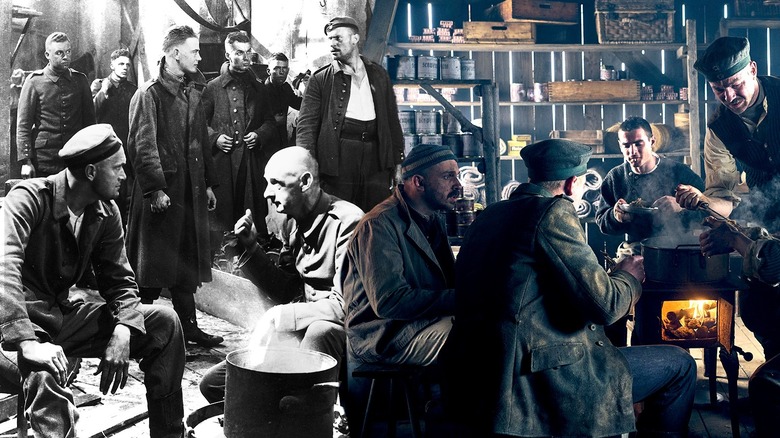
The following contains spoilers for "All Quiet on the Western Front."
The biggest difference between the two theatrical versions of "All Quiet on the Western Front" is the specific perspective they bring to the story of German soldier Paul Bäumer and his friends and fellow enlistees during World War I. There have actually been three adaptations of Erich Maria Remarque's 1929 novel, "All Quiet on the Western Front," but one was a TV movie. The original 1930 theatrical version was the first literary adaptation to win Best Picture and the first film to ever win both that category and Best Director at the 3rd Academy Awards.
Now, over nine decades later, the most recent Netflix adaptation of "All Quiet on the Western Front" has joined the ranks of "Parasite," "Crouching Tiger, Hidden Dragon," and "Fanny and Alexander" to become one of four foreign-language films with the most wins in Oscar history. It nabbed Best International Feature, Best Cinematography, Best Original Score, and Best Production Design at this year's 95th Academy Awards.
The 1930 version of "All Quiet on the Western Front" was an English-language American film, released near the outset of the Great Depression, just 11 years after World War I ended. With the war fresh in mind and its shell-shocked survivors, many born in the 19th century, now making up what came to be known as the Lost Generation (the last of whom died in 2018), it's not surprising that the film would begin with the disclaimer that it is "neither an accusation nor a confession, and least of all an adventure," but rather a story of lives "destroyed by the war."
While in some ways the new Netflix adaptation remains in conversation with the original film across the decades, it's a homegrown German production with a much greater distance of time and history separating it from the war.
Inside The War Machine
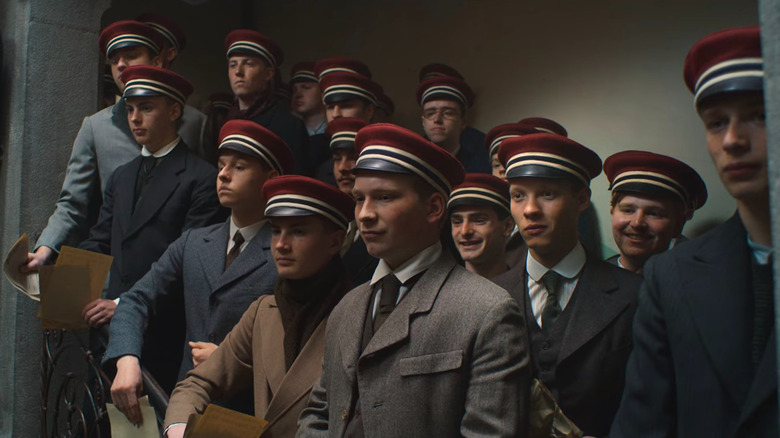
From its opening frames, Netflix's "All Quiet on the Western Front" lets the viewer feel that distance as it assumes a more omniscient perspective. Nature scenes give way to a burned-out battlefield littered with bodies, as the camera looks straight down in a God's-eye view until it's gliding along the ground and down into the trenches with a terrified infantryman. His name, Heinrich (Jakob Schmidt), is sewn into his coat, but it's not long before it's stripped from his corpse and passed onto Paul (Felix Kammerer) by a recruiter.
In the original "All Quiet on the Western Front," there's a scene where we see a pair of boots handed down from one fallen soldier after another, but it's more of an aside that comes later in the movie. Netflix's version, directed by Edward Berger, expands on the idea to show how the lives of soldiers are fed through the gristmill to become material artifacts like a pile of dog tags. This is complemented by Volker Bertelmann's music, which keeps the viewer on edge as it cranks like a ratchet as tight and tense as the ticking-time-bomb score of "Dunkirk." Crashing noises, barely discernible as military drums, invade the soundtrack at odd intervals, and it's as if we're inside the war machine, both seeing and hearing it operate.
Paul and his friends enlist to become the "Iron Youth of Germany" with the same naivete, though we don't see them sitting in a classroom fantasizing about "the adulation of heroes" and homecoming parades they'll receive, as we do in the 1930 version, directed by Lewis Milestone. Instead, they stand in a stairwell in their red German field caps as they listen to an impassioned speech about all the great deeds they will do "for Kaiser, God, and Fatherland."
'This Isn't How I Imagined It'
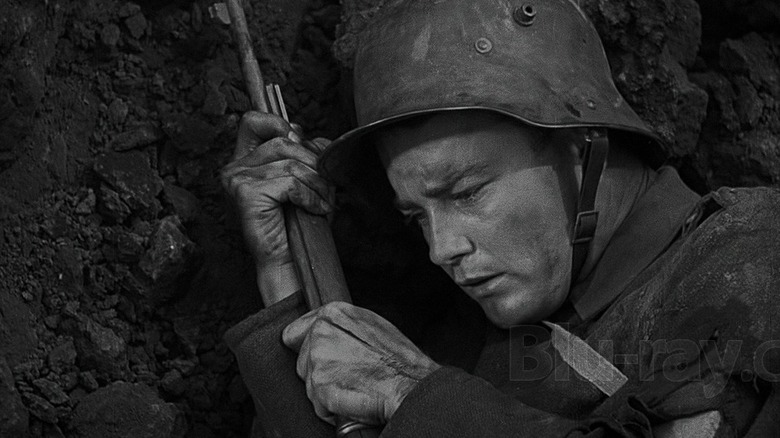
In both versions of "All Quiet on the Western Front," cheers go up and papers fly before Paul and the boys march off to battle, but while it's all fun and games at first, the harsh realities of war soon set in, trumping innocence with experience. "This isn't how I imagined it," one character protests. Paul's face in the 1930 version looks different from how illustrator Karoly Grosz rendered it in the movie poster. Grosz became known for his iconic Universal Classic Monster posters, whereas Lew Ayres, the actor who plays Paul, almost resembles a young John Wayne at times. Unlike Wayne's strident, pro-military "The Green Berets," however, "All Quiet on the Western Front" is an anti-war film.
Only the 1930 version introduces the character Himmelstoss (John Wray), the boys' former postman, who becomes a different person when he puts on an officer's uniform. (One of the young soldiers also takes pride in his boots, made of specially imported leather.) Himmelstoss abuses his newfound authority over them until they ambush his drunken self one night, tie him up, and give him a good '30s spanking. He's a coward, and Paul confronts him on the battlefield after he treats a minor scratch like a serious wound, whereupon the rallying sight of another officer inspires Himmelstoss to rush out and meet his death.
The original "All the Quiet on the Western Front" also shows the horrors of war with images like a pair of severed hands hanging from barbed wire. Yet the imagery in the 2022 version is even more nightmarish, as Paul dons a gas mask and his superior warns him that he'll "almost certainly be dead by dawn," not unlike the room full of bodies they find who removed their masks too soon.
Kings And Pawns
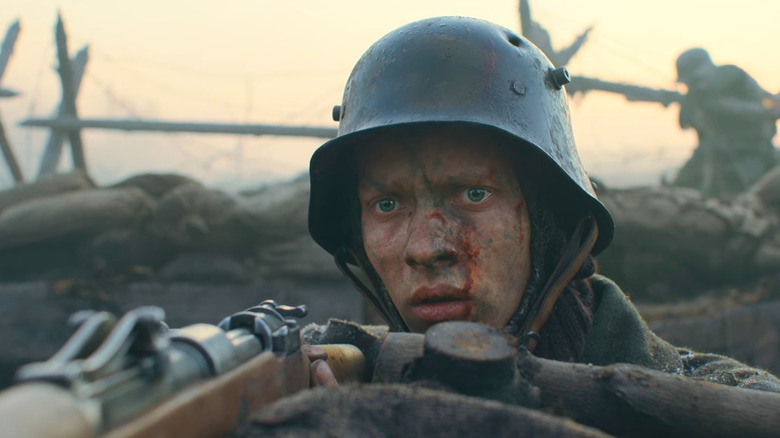
The first "All Quiet on the Western Front" puts its focus on the men on the ground. Rather than stealing geese from a farm with Paul as he does in the 2022 version, Kat (Louis Wolheim) goes out looking for food on his own and eventually swipes a slaughtered pig before it can be loaded onto the back of a truck. Wolheim died months after the film's release, and some of his dialogue is the most dated yet colorful, such as when a cook asks Kat what he wants and he fires off lines like, "Beans, ya homely-lookin' son of a frog's leg," and, "You're the yellowest baboon who ever drew a cook's wagon."
It's Kat who envisions a solution to the war that would involve roping off a field and letting all the kings and generals duke it out there in their underwear. Netflix's "All Quiet on the Western Front" — which was made with the added benefit of World War II hindsight — does unclothe how the stubborn whims of military leaders, who dine on fruit and cheese, decide the fate of soldiers on the frontlines.
One major addition to the 2022 film is the subplot with real-life historical figure Matthias Erzberger (Daniel Brühl), head of the German delegation sent to negotiate an armistice with France. Other Germans don't want to capitulate to the terms the French have dictated (under a 72-hour deadline), but Erzberger recognizes that the war is already lost and they could save more lives by agreeing to the terms now. Meanwhile, General Friedrichs (Devid Striesow) throws food to the dogs from his banquet table and makes one last push for German victory even after a ceasefire has been set for the 11th hour of the 11th month of the 11th day.
Bayonet And Butterfly
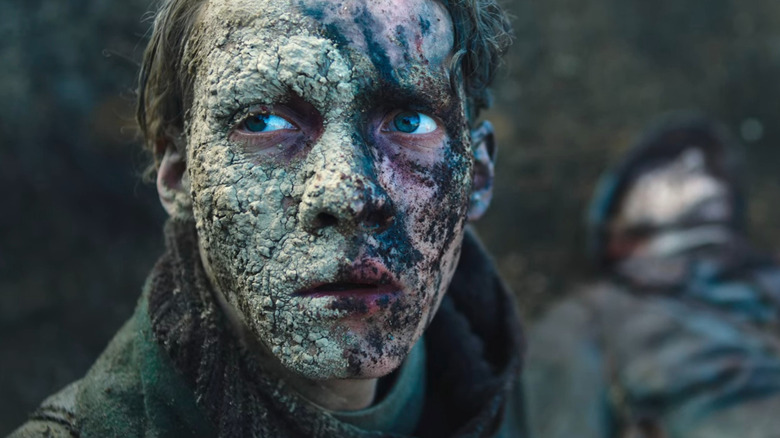
One evocative image in Netflix's "All Quiet on the Western Front" shows a close-up of Paul's face, half of it caked with mud, the other half blackened with dirt. The audience witnesses firsthand the dual nature of humanity and inhumanity, as Paul gets trapped in a crater with an enemy soldier and brutally stabs him, then becomes apologetic, bringing him water as he dies. This scene is less horrific in the 1930 film, where there's no flamethrower death or graphic fork to the throat, either, as shown with Ludwig (Adrian Grunewald) and Tjaden (Edin Hasanovic).
The 2022 version excludes Paul's pivotal return home, where he meets his mother and his old teacher asks him to say something to inspire the next class, only for them to heckle him when he suggests it's better not to die than die for one's country. Ludwig's ripped poster woman never leaves the wall in the 1930 adaptation, but Paul and two of his friends do leave to meet the French girls, who they first encounter while swimming.
In the Netflix version, it's the farmer's son who catches up with Kat (Albrecht Schuch), whereas a bombing kills him in the original. Paul himself is bayoneted in the back right before the ceasefire, when things truly do go quiet on the western front. In the original, he's shot while reaching for a butterfly.
The final image from 1930 shows a field of graves, superimposed with soldiers looking back over their shoulders while marching. In the 2022 version, the loss of life and futility of war is underscored by the postscript, which explains how the frontline barely moved during World War I and three million soldiers died "often while fighting to gain only a few 100 meters of ground."
Read this next: The Best Movies Of 2022
The post The Major Differences Between the Two All Quiet on the Western Front Films appeared first on /Film.
/Film https://ift.tt/731NEGQ March 27, 2023 at 12:45PM
Комментарии
Отправить комментарий